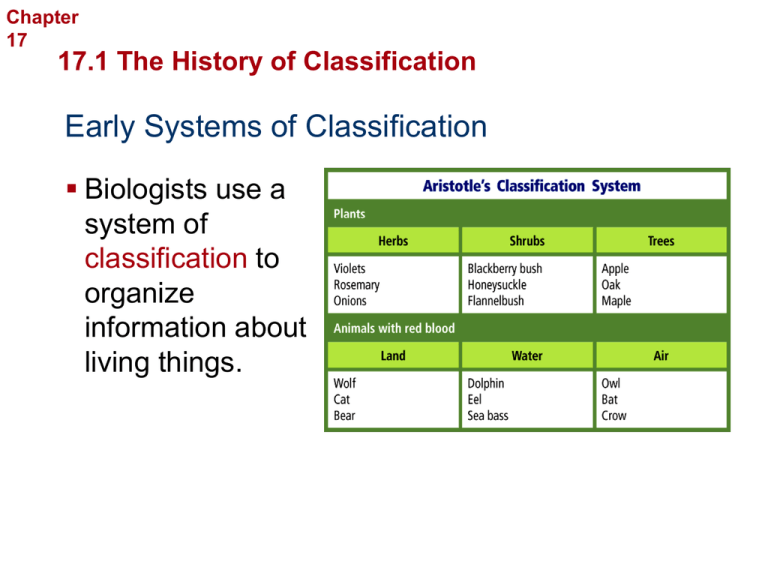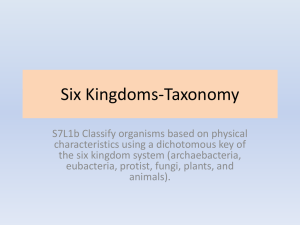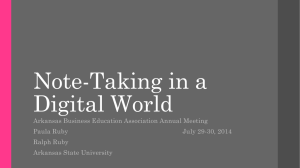17.1 The History of Classification Chapter 17
advertisement

Chapter 17 Organizing Life’s Diversity 17.1 The History of Classification Early Systems of Classification Biologists use a system of classification to organize information about living things. Chapter 17 Organizing Life’s Diversity 17.1 The History of Classification Aristotle’s System Aristotle classified organisms as either animals or plants. Often times used many descriptive terms Chapter 17 Organizing Life’s Diversity 17.1 The History of Classification Linnaeus’s System Linnaeus’s system of classification was the first formal system of taxonomy. Perching bird Bird of prey Wading bird Chapter 17 Organizing Life’s Diversity 17.1 The History of Classification Binomial Nomenclature Linnaeus’s method of naming organisms, called binomial nomenclature, gives each species a scientific name with two parts. The first part is the genus name, and the second part is the species. Ex. Ursus americanus Chapter 17 Organizing Life’s Diversity 17.1 The History of Classification Why classify? Biologists use scientific names for species because common names vary in different areas of the world. Establishes a “standard” Ursus americanus American black bear Chapter 17 Organizing Life’s Diversity 17.1 The History of Classification Rules for scientific naming: The first letter of the genus name always is capitalized, but the rest of the genus name and all letters of the species are lowercase. If a scientific name is written in a printed book or magazine, it should be italicized. When a scientific name is written by hand, both parts of the name should be underlined. After the scientific name has been written completely, the genus name will be abbreviated to the first letter in later appearances (e.g., C. cardinalis). Chapter 17 Organizing Life’s Diversity 17.1 The History of Classification Taxonomic Categories The taxonomic categories are part of a hierarchal system. Each category is contained within another, and they are arranged from broadest to most specific. Chapter 17 Organizing Life’s Diversity 17.1 The History of Classification Species and Genus A named group of organisms is called a taxa. A genus is a group of species that are closely related and share a common ancestor. Chapter 17 Organizing Life’s Diversity 17.1 The History of Classification Family A family is the next higher taxon, consisting of similar, related genera. Chapter 17 Organizing Life’s Diversity 17.1 The History of Classification Higher Taxa An order contains related families. A class contains related orders. A phylum contains related classes. The taxon of related phyla or divisions is a kingdom. The domain is the broadest of all the taxa and contains one or more kingdoms. Grizzly bear Black bear Giant panda Red fox Abert squirrel Coral snake Sea star KINGDOM Animalia PHYLUM Chordata CLASS Mammalia ORDER Carnivora FAMILY Ursidae GENUS Ursus SPECIES Ursus arctos Chapter 17 Organizing Life’s Diversity 17.1 The History of Classification Species and Genus A named group of organisms is called a taxa. A genus is a group of species that are closely related and share a common ancestor. Chapter 17 Organizing Life’s Diversity 17.2 Modern Classification Typological Species Concept Aristotle and Linnaeus thought of each species as a distinctly different group of organisms based on physical similarities. Chapter 17 Organizing Life’s Diversity 17.2 Modern Classification Biological Species Concept How do scientists tell these species apart to classify them? Think back to speciation! biological species a species as a group of organisms that is able to interbreed and produce fertile offspring. Chapter 17 Organizing Life’s Diversity 17.2 Modern Classification Biological Species Concept However, these barriers are not always complete & different species can interbreed to form viable offspring: hybrids Hybrid Panthera leo x Panthera tigris P. leo x P. tigris Hybrids Equus caballus x Equus asinus E. Caballus x E. asinus Classification • But making evolutionary connections based on similar traits can be misleading • Organisms can look similar but not share a common ancestor • So how do we distinguish between such relationships? Chapter 17 Organizing Life’s Diversity 17.2 Modern Classification Phylogenic Species Concept Phylogeny is the evolutionary history of a species. The phylogenic species concept shows evidence of a pattern of ancestry and descent. Chapter 17 Organizing Life’s Diversity 17.2 Modern Classification Morphological Characters Shared morphological characters suggest that species are related closely and evolved from a recent common ancestor. Analogous characters the same function but different underlying construction. Homologous characters different functions, but show an anatomical similarity inherited from a common ancestor. Chapter 17 Organizing Life’s Diversity 17.2 Modern Classification Biochemical Characters Scientists use biochemical characters, such as amino acids and nucleotides, to help them determine evolutionary relationships among species. DNA and RNA analyses are powerful tools for reconstructing phylogenies. Chapter 17 Organizing Life’s Diversity 17.2 Modern Classification Phylogenetic Reconstruction Cladistics reconstructs phylogenies based on shared characters. Scientists consider two main types of characters when doing cladistic analysis. An ancestral character is found within the entire line of descent of a group of organisms. Derived characters are present members of one group of the line but not in the common ancestor. Chapter 17 Organizing Life’s Diversity 17.2 Modern Classification Cladograms The greater the number of derived characters shared by groups, the more recently the groups share a common ancestor. Section 18-2 Traditional Classification Versus Cladogram Appendages Crab Conical Shells Barnacle Limpet Crustaceans Crab Barnacle Gastropod Limpet Molted exoskeleton Segmentation CLASSIFICATION BASED ON VISIBLE SIMILARITIES Tiny free-swimming larva CLADOGRAM Chapter 17 Organizing Life’s Diversity 17.3 Domains and Kingdoms Grouping Species The three domains are Bacteria, Archaea, and Eukarya. The six kingdoms are Eubacteria, Archaebacteria, Protista, Fungi, Plantae, and Animalia. Chapter 17 Organizing Life’s Diversity 17.3 Domains and Kingdoms Domain Bacteria Eubacteria are prokaryotes whose cell walls contain peptidoglycan. Chapter 17 Organizing Life’s Diversity 17.3 Domains and Kingdoms Domain Archaea Archaea are thought to be more ancient than bacteria and yet more closely related to our eukaryote ancestors. Cell walls without peptidoglycan They are called extremophiles because they can live in extreme environments. Chapter 17 Organizing Life’s Diversity 17.3 Domains and Kingdoms Domain Eukarya All eukaryotes are classified in Domain Eukarya. Domain Eukarya contains Kingdom Protista, Kingdom Fungi, Kingdom Plantae, and Kingdom Animalia. Chapter 17 Organizing Life’s Diversity 17.3 Domains and Kingdoms Kingdom Protista Protists are eukaryotic organisms that can be unicellular, colonial, or multicellular. Protists are classified into three different groups— plantlike, animallike, and funguslike. Chapter 17 Organizing Life’s Diversity 17.3 Domains and Kingdoms Kingdom Fungi A fungus is a unicellular or multicellular eukaryote that absorbs nutrients from organic materials in its environment. Member of Kingdom Fungi are heterotrophic, lack motility, and have cell walls. Chapter 17 Organizing Life’s Diversity 17.3 Domains and Kingdoms Kingdom Plantae Members of Kingdom Plantae form the base of all terrestrial habitats. All plants are multicellular and have cell walls composed of cellulose. Most plants are autotrophs, but some are heterotrophic. Chapter 17 Organizing Life’s Diversity 17.3 Domains and Kingdoms Kingdom Animalia All animals are heterotrophic, multicellular eukaryotes. Animal organs often are organized into complex organ systems. They live in the water, on land, and in the air. Making a Cladogram Chapter 17 Organizing Life’s Diversity 17.3 Domains and Kingdoms









